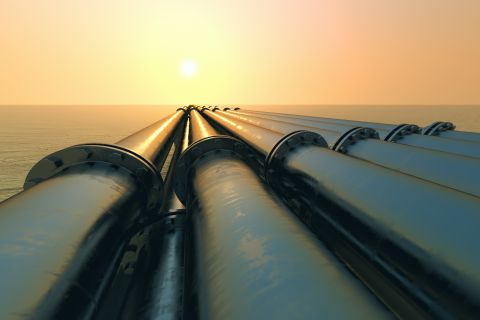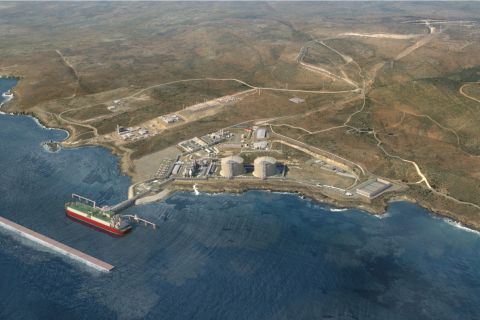?Another brilliant Brazilian discovery was announced by Anadarko Petroleum Corp. in the Campos Basin, offshore Brazil. The #1-APL-1-ESS deep, pre-salt discovery reportedly flowed 18,000 barrels of light oil per day from a 195-foot net pay zone.
The well is in the Wahoo prospect on Block BM-C-30 offshore Brazil, in more than 4,600 feet of water. Anadarko reports that the Wahoo find has characteristics similar to nearby Petrobras pre-salt discoveries at Jubarte Field, Brazil’s first producing pre-salt field. The Anadarko well is about 25 miles southeast and syncline-separated from Jubarte.
Anadarko used the record-setting drillship, Deepwater Millennium, to drill #1-APL-1-ESS. Once drilling operations are completed at Wahoo, Anadarko plans to move the drillship to the Espirito Santo Basin to reenter a Serpa block well in the BM-ES-24 block. Drilling at Serpa was halted because of rig limitations; hydrocarbons have already been found in a secondary objective.
Anadarko operates the concession and has a 30% working interest. Other working-interest-holders include Devon Energy Corp. with 25%; EnCana Brasil Petroleo Ltd., a wholly owned subsidiary of Bharat PetroResources Ltd. and Videocon Industries, with 25%; and SK do Brazil Ltd., with the remaining 20%.
?1 North Sea
StatoilHydro ASA reports that it found a 100-meter oil column in its #15/5-7 well in the Hugin formation of the Sleipner area. The #15/5-7 appraisal confirmed the presence of oil in Mid-Jurassic reservoir rocks below the Dagny gas discovery. Drilled in some 119 meters of water, StatoilHydro estimates that 100- to 125 million bbl. of oil equivalent is recoverable. The size of the Dagny discovery, however, is being re-estimated to contain between 130- and 170 million bbl. of oil equivalent?now that drilling the sidetrack well has been done. Gas and condensate were encountered in the Middle Jurassic Hugin formation. Block 15/5 is operated by StatoilHydro ASA with a 78.2% stake, and Total SA holds the remaining 21.8%. StatoilHydro is headquartered in Stavanger, Norway.
2 Libya
Sirte Oil Co., a wholly owned subsidiary of the Libya’s National Oil Co. (NOC), reports a major discovery in Tannezuft sands at a depth of 10,662 ft. in Libya’s Ghadames Basin. The #A1-NC216A, in Block NC216A, 310 kilometers southwest of Tripoli, flowed 1,725 bbl. of 42.1-degree API oil per day, along with 250,000 cu. ft. of gas. This is the first discovery and the first well drilled by Sirte on this block. A recent discovery by Calgary-based Verenex Energy at #C1-47/04 was also reported in the Ghadames Basin. That find, made 150 kilometers southwest of Tripoli, was tested flowing 1,350 bbl. of light, sweet crude and 10.3 million cu. ft. of gas per day.
3 Kazakhstan
According to Alexander’s Gas and Oil Connections, Volga Gas reports the discovery of 2,000 bbl. of 45-API oil per day in the Karpenskiy license area, east of Volgograd. Uzenskaya #3 was an exploration project targeting a Jurassic structure close to Uzenskaya Field, discovered earlier this year. An interval between 989-1,011 meters was open-hole tested and flowed at an equivalent of 2,220 bbl. of light oil per day during a drillstem test. Testing confirmed the horizon’s excellent permeability. The well is currently being connected to existing Uzenskaya facilities. A new well, Uzenskaya #4, has been spudded to determine the extent of the field.
4 Russia
According to E&P Daily, Lundin Petroleum, Stockholm, reports the Morskaya discovery in the Russian sector of the Caspian Sea contains between 110- and 450 million bbl. of recoverable oil reserves. The Morskaya-1 was drilled and completed in mid-2008 on the Lagansky Block. It encountered a major oil accumulation in the Aptian and Neocomian sandstone reservoirs with minor amounts of gas in the overlying Albian reservoir. Morskaya-1 was drilled to a depth of 2,082 meters in a water depth of about two meters. The Morskaya structure is a large, four-way dip closure, and the extent of the discovery is approximately 130 square kilometers. Further appraisal drilling will be needed to assess the full extent of the reservoirs. The first appraisal well is planned for 2009, after 3-D seismic surveys are complete.
5 Georgia
Houston-based Frontera Resources Corp. reports positive results from a development program in Mtsare Khevi Field. Four recent wells have been drilled targeting the Upper Pliocene-age Akchagil formation: #13MK, #14MK, #22MK and #23MK were drilled to around 355 meters and each encountered three hydrocarbon-bearing zones between 200-315 meters. Initial results indicate a structure larger than anticipated. New plans require remapping of the field and drilling about 40 wells in 2009. The #12MK and #13MK currently produce about 31 bbl. of 21-degree API oil per day. Once in production, Frontera expects to produce 250 bbl. per day, and 400 bbl. per day after additional exploration and testing of Pliocene and Miocene reservoirs. Mtsare Khevi Field is in the western portion of Block 12.
6 Abu Dhabi
IHS Inc. reports a recent agreement by Occidental Petroleum Corp., Los Angeles, and Abu Dhabi National Oil Co. (Adnoc) for appraisal and development rights to Jarn Yaphour and Rahman fields in Abu Dhabi. Occidental will pay $500 million to develop the fields and will receive 100% of field output through 2012. First production from onshore Jarn Yaphour Field, near the capital city of Abu Dhabi, is scheduled for 2009. Production of 10,000 bbl. of oil equivalent per day is anticipated. Rahman Field lies in shallow water near the Abu Dhabi refinery and was tested in 1992 from one well at a rate of 1,750 bbl. of oil per day and 14 million cu. ft. of gas. First production from the field could commence as early as 2011.
7 Myanmar
Goldpetrol, a subsidiary of Interra Resources, has spudded a deep development well, #3232 Yenangyaung, in Yenangyaung Field that targets oil sands in the Okhmintaung formation. The location is in a northern fault block of Yenangyaung Field that has 20 producing wells. It will be drilled northwest of a well that has produced around 325,000 bbl. of oil. The new test has a target depth of 2,377 meters and is planned to penetrate deeper sands in the Padaung formation.
8 China
In the Yellow River Sag, CNOOC Ltd. is reporting a Bohai Bay discovery. The BZ #35-2-2 tested at a rate of 560 bbl. of oil per day, along with 32,000 cu. ft. of gas. Drilled to 3,225 meters in a water depth of approximately 20 meters, the pay zones were 31.2 meters thick. CNOOC Ltd. holds 100% of the discovery.
9 Philippines
Perth, Australia-based Otto Energy, operator of the Galoc Field development in the Palawan Basin, offshore Philippines, is reporting that Galoc-3 has been flow-tested at a stabilized rate of more than 5,200 bbl. of oil equivalent per day. The well is now ready to be connected to a floating production, storage and offloading vessel, and is currently flowing at rates up to 5,397 bbl. per day. A second well, Galoc 4, will soon be online and total field production is expected to be more than 15,000 bbl. per day. Galoc Field is about 65 kilometers northwest of Palawan, Philippines. Partners in Galoc 4 include Galoc Production Co., with 58%; Nido Petroleum, with 22%; and a Philippine consortium with 20%.
10 New Zealand
L&M Petroleum’s Goodwin-1 exploration well in New Zealand’s PEP 38226 permit, on South Island, has shown the presence of gas and signaled that coalbed-methane horizons have very low water contents. The sampled Morley layers were oversaturated with gas. A total of 36 ft. of coal was recovered from the Morley formation during coring operations. IHS Inc. reports that exploration continues at the Wairaki site in the adjacent permit PEP 38238. Two wells will be drilled to establish the depth of the top of the Beaumont coals in the northern end of the Takitimu South trend. L&M Petroleum’s headquarters are in Wellington.
Recommended Reading
Midstream Builds in a Bearish Market
2024-03-11 - Midstream companies are sticking to long term plans for an expanded customer base, despite low gas prices, high storage levels and an uncertain political LNG future.
Gas Prices in a Summer of Discontent
2024-05-14 - In February, natural gas prices dropped below $2/MMBtu and stayed there. How is the market handling it, and when will the price pick back up?
Heard from the Field: US Needs More Gas Storage
2024-03-21 - The current gas working capacity fits a 60 Bcf/d market — but today, the market exceeds 100 Bcf/d, gas executives said at CERAWeek by S&P Global.
Turning Down the Volumes: EQT Latest E&P to Retreat from Painful NatGas Prices
2024-03-05 - Despite moves by EQT, Chesapeake and other gassy E&Ps, natural gas prices will likely remain in a funk for at least the next quarter, analysts said.
Permian Gas Finds Another Way to Asia
2024-04-30 - A crop of Mexican LNG facilities in development will connect U.S. producers to high-demand markets while avoiding the Panama Canal.





